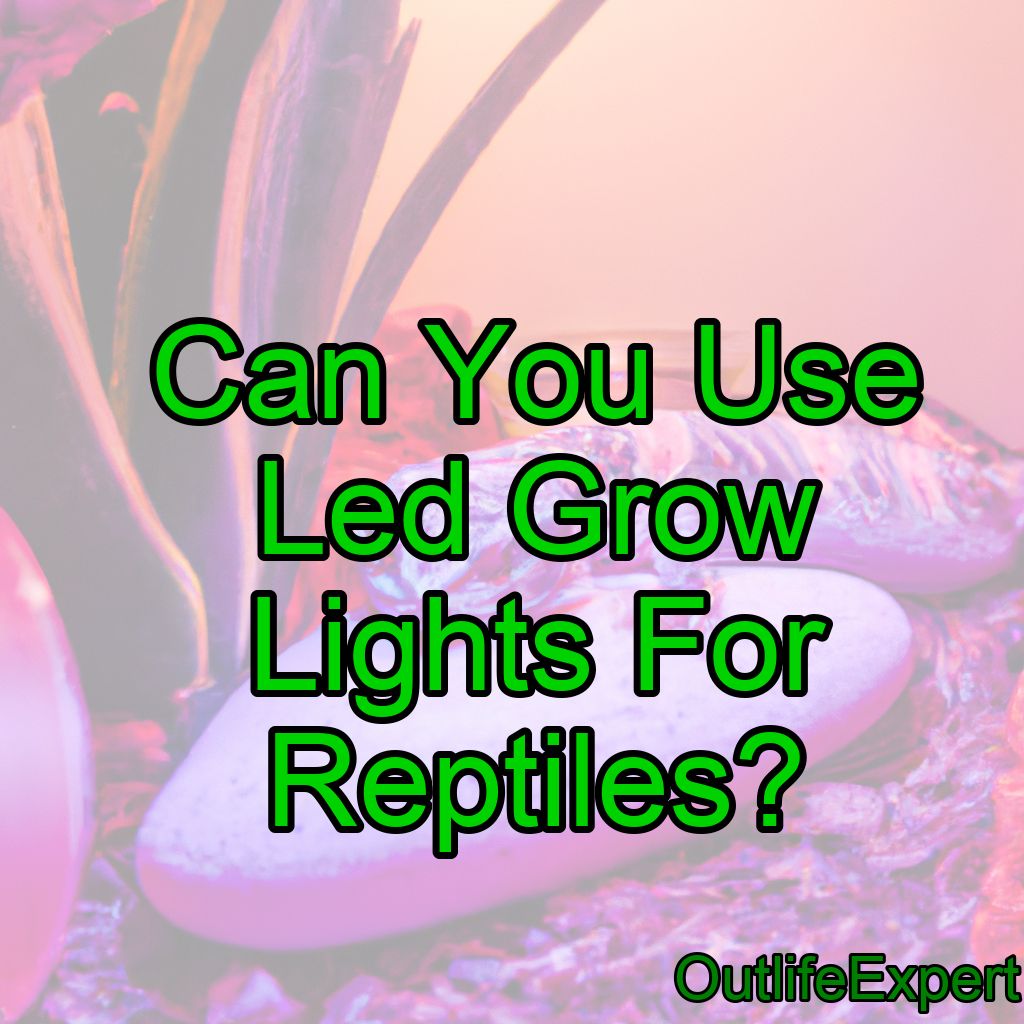Are you looking for a way to provide your reptiles with the best care possible? LED grow lights are becoming increasingly popular, and many people wonder if they can use them to keep their reptile pets healthy.
Yes, you can use LED grow lights for reptiles, but it is essential to ensure that the lights provide the necessary wavelengths and intensity to meet the specific needs of your reptile species. Consider the following factors when using LED grow lights for reptiles:
1. UVB output: Reptiles require UVB light for synthesizing vitamin D3, which is crucial for calcium absorption and overall health. Choose LED grow lights that emit adequate levels of UVB radiation suitable for your reptile species.
2. UVA output: UVA light plays a role in reptile behavior, such as feeding and mating. Ensure that the LED grow lights emit UVA wavelengths to support your reptile’s well-being.
3. Heat generation: Reptiles are ectothermic and rely on external heat sources to regulate their body temperature. LED grow lights typically produce less heat than traditional reptile basking bulbs, so you may need to supplement with a separate heat source to maintain the appropriate temperature gradient in the enclosure.
4. Light intensity and duration: Different reptile species have varying light intensity and photoperiod requirements. Adjust the LED grow lights’ intensity and duration to mimic the natural light cycle of your reptile’s native habitat.
5. Proper placement: Position the LED grow lights at an appropriate distance from the reptile to prevent overheating and ensure adequate UV exposure. Consult care guidelines for your specific reptile species to determine the optimal distance.
In summary, LED grow lights can be used for reptiles if they meet the necessary UVB, UVA, and heat requirements. Always research your reptile species’ specific needs and consult with a veterinarian or reptile expert to ensure the proper setup for your pet’s health and well-being.**
LED grow lights offer many benefits over traditional lighting options. They produce less heat than other bulbs, which is essential since most reptiles come from warmer climates. They also last longer and provide more intense light without wasting energy or emitting harmful UV rays.
With all these advantages in mind, it’s no surprise that LED lighting has become so popular among reptile owners. Keep reading to learn how to safely incorporate LED grow lights into your pet’s habitat!
What Is Led Grow Lighting?
LED grow lighting has become increasingly popular in recent years. With its low heat generation, cost efficiency and even customizable lighting spectrum, it’s easy to understand why.
But what exactly is LED grow lighting?
LED stands for light-emitting diode, which are small diodes that convert electricity into visible light. When grouped together in the form of a panel or bulb, they can produce powerful yet energy-efficient light sources for indoor gardening applications.
Safety precautions should be taken when using LED bulbs as some require high voltage power supplies and come with specific installation instructions. Additionally, there’s also the issue of bulb lifespan—the average LED bulb lasts approximately 25 times longer than traditional incandescent bulbs.
Transitioning from this section about what is LED grow lighting to the subsequent one on benefits of LED grow lighting for reptiles…
Benefits Of Led Grow Lighting For Reptiles
LED grow lights offer a variety of benefits for reptile owners. Heat regulation and UV exposure are two of the most important considerations when it comes to keeping reptiles healthy, and LED lighting can provide both in optimal levels.
The color spectrum emitted by LED bulbs is also closer to natural sunlight than other types of grow light, which allows reptiles to better regulate their body temperature. Additionally, LED lighting provides adjustable lighting intensity so that you can tailor your reptile’s environment precisely to its needs.
Lighting plays an essential role in preventing illness in reptiles as well; too much or too little light can cause stress-related health issues.
By using LED lighting, you can more easily adjust the level of light they’re exposed to while providing necessary warmth and beneficial ultraviolet radiation (UV). This helps keep them strong and healthy with minimal effort on your part.
It’s clear that LED grow lighting offers numerous advantages for reptilian species – now let’s discuss how to set up an effective system for your pet!
Led Grow Lighting Setup For Reptiles
Setting up an LED grow light for reptiles is like a symphony of colors in motion. Installing the setup can be quite simple, but there are several factors to consider when making your decision.

Heat requirements are important; you don’t want to keep them too hot or too cold. The right light spectrum is also necessary, as well as adequate light intensity and cost comparison with other lighting options.
When considering all these elements together, it’s clear that LED grow lights have many advantages over traditional reptile habitats. However, one must remember that this type of light carries certain risks if not used properly.
It’s essential to understand what those risks may be before moving forward with installation and use.
Dangers To Consider When Using Led Grow Lighting For Reptiles
When using LED grow lighting to provide light for your reptile, there are several important points you must consider in order to ensure their health and safety.
Reptiles can become stressed if they experience too much light or heat radiating from the bulbs, so be sure to keep up with regular maintenance of the enclosure size and its temperature regulation.
Additionally, it is important that your reptile receives adequate UV exposure as well – some reptiles require more than others do.
It is also vital to make sure you select an LED grow light device with a low energy consumption rate; this will save you money on electric bills while avoiding any potential wattage issues within the habitat.
If either of these factors aren’t properly taken into consideration when selecting a product, then you may find yourself dealing with serious consequences down the line such as damaged equipment due to overuse or sickly reptiles due to lack of appropriate care.
Therefore, before purchasing any type of LED grow lights meant for use with reptiles, take careful measures to analyze all aspects of their setup including but not limited to: power output, intensity levels, duration times, temperature range and size of enclosure.
Doing so will help guarantee your pet has everything necessary for a long and healthy life under artificial lighting conditions!
Frequently Asked Questions
Are Led Grow Lights Suitable For All Types Of Reptiles?
When it comes to reptiles and LED grow lights, there are many factors to consider – heat output, light spectrum, health benefits, installation costs, and energy efficiency.
As an outdoor expert I can tell you that while LED grow lights may not be suitable for all types of reptiles due to their specific needs, they can offer a great deal of potential in terms of providing the right type of lighting for your pet reptile.
LEDs have low levels of heat output compared to traditional bulbs so don’t worry about excessive warmth affecting your reptile’s environment.
In addition, depending on which type of LEDs you opt for you will get customisable light spectrums which means healthier growth and activity cycles for your reptile.
The installation cost of LED grow lights is usually lower than other forms and with their high energy efficiency ratings you will save money on electricity bills too!
What Is The Best Distance Between The Led Grow Light And The Reptile?
Proper installation and planning of LED grow lights for reptiles is essential for their health and well-being.
As an outdoor expert, I recommend considering the wattage requirements, UVB output, light intensity, ambient temperature, and distance between the reptile and the light before installing your LED grow light set up.
To ensure optimal performance of your LED grow lights while creating a comfortable environment for your reptile, you’ll want to keep the proper balance between these elements.
This will give them freedom to thrive in their natural habitat without sacrificing safety or comfort.
Are Led Grow Lights More Expensive Than Traditional Reptile Lighting?
The short answer is yes, but the long answer depends on your needs. To start with, you have to consider dimming controls, light spectrum, UV output, heat output and power consumption when choosing a lighting source for reptiles.
While LED grow lights may be more expensive upfront, they can provide tremendous savings in the long run due to their low energy usage and increased longevity compared to other types of lighting sources.
Plus, by using an LED grow light you don’t need to worry about harmful UV rays or excessive heat that could limit your reptilian friend’s freedom!
All-in-all, it’s up to you decide whether or not investing in an LED grow light is worth the cost.’
How Long Do Led Grow Lights Typically Last?
If you’re looking for a reliable and energy-efficient way to light your reptile’s environment, LED grow lights are an excellent choice.
Not only do they emit very little heat output compared to traditional lighting systems, but their bulbs also last up to 50% longer than typical incandescent or fluorescent lights.
Furthermore, LED grow lights provide unparalleled intensity of light, making them perfect for cultivating plants in even the darkest corners of the world.
And with no need to replace bulbs as often, you can use these lights without worrying about their environmental impact.
So if you want long-lasting illumination that won’t break the bank, look into investing in some LED grow lights today!
Are Led Grow Lights Safe For My Reptile To Be Exposed To For Extended Periods Of Time?
As an outdoor expert, I understand the importance of temperature control and light exposure for reptiles. LED grow lights are a great option when it comes to providing your reptile with UVB intensity, as they offer all the necessary components to keep them healthy, including color spectrum and bulb wattage.
But before you commit to this type of lighting system, consider if your pet will be exposed to these lights for extended periods of time – is it safe?
Absolutely! With proper use and regulation of power output, LED grow lights can provide your reptile with a sense of freedom that only controlled light exposure can bring.
Conclusion
As an outdoor expert, I can confidently say that LED grow lights are suitable for a variety of reptiles. They provide the right amount and intensity of light needed to keep your pet healthy and happy.
Not only do they last longer than traditional reptile lighting options, but they’re also more energy efficient as well. Additionally, you don’t need to worry about them being too close to your reptile since most LED lights have built-in safeguards against overheating.
Overall, investing in LED grow lights is a wise decision when it comes to caring for reptiles. It’s important that you find a distance between the light and your pet that works best for their species so that they get enough exposure without becoming uncomfortable or overstimulated.
As long as you follow these guidelines, you’re sure to be satisfied with your choice of LED grow lights!




